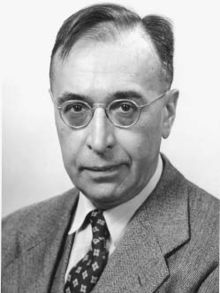Gregory Breit
Gregory Breit | |
|---|---|
Григорий Альфредович Брейт-Шнайдер | |
 Photograph of Gregory Breit | |
| Born | Gregory Alfredovich Breit-Schneider June 14, 1899 |
| Died | September 13, 1981 (aged 82) Salem, Oregon, USA |
| Alma mater | Johns Hopkins University |
| Known for | |
| Awards | Franklin Medal (1964) National Medal of Science (1967) Tom W. Bonner Prize in Nuclear Physics (1969) |
| Scientific career | |
| Fields | Physics |
| Institutions |
|
| Doctoral advisor | Joseph S. Ames |
Gregory Breit (Russian: Григорий Альфредович Брейт-Шнайдер, Grigory Alfredovich Breit-Shneider; July 14, 1899, Mykolaiv, Kherson Governorate – September 13, 1981, Salem, Oregon) was a Russian-born Jewish American physicist[1] and professor at New York University (1929–1934), University of Wisconsin–Madison (1934–1947), Yale University (1947–1968), and University at Buffalo (1968–1973).[2] In 1921, he was Paul Ehrenfest's assistant in Leiden University.
Biography[]
In 1925, while at the Carnegie Institution of Washington, Breit joined with Merle Tuve in using a pulsed radio transmitter to determine the height of the ionosphere, a technique important later in radar development.[3]
Together with Eugene Wigner, Breit gave a description of particle resonant states with the relativistic Breit–Wigner distribution in 1929, and with Edward Condon, he first described proton-proton dispersion. He is also credited with deriving the Breit equation.[4] The Breit frame of reference is named after him.[5] He was one of the first to notice the zitterbewegung (jittery motion) in the solutions of the Dirac equation.[6][7]
In 1934, together with John A. Wheeler, Breit described the Breit–Wheeler process. In 1939 he was elected to the National Academy of Sciences. In April 1940, he proposed to the National Research Council that American scientists observe a policy of self-censorship due to the possibility of their work being used for military purposes by enemy powers in World War II.[8]
During the early stages of the war, Breit was chosen by Arthur Compton to supervise the early design of the first atomic bomb during an early phase in what would later become the Manhattan Project. Breit resigned his position in 1942, feeling that the work was going too slowly and that there had been security breaches on the project; his job went to Robert Oppenheimer, who was later appointed to scientific director of the entire project.
In 2014, experimentalists proposed a way to validate an idea by Breit and John A. Wheeler that matter formation could be achieved by interacting light particles ("Breit–Wheeler process").[9]
Breit was Associate Editor of the Physical Review four times (1927-1929, 1939-1941, 1954-1956, and 1961-1963).
He was awarded the Franklin Medal in 1964. In 1967, he was awarded the National Medal of Science.[10]
References[]
- ^ Hull, Jr., McAllister H. (October 1983). "Obituary: Gregory Breit". Physics Today. 36 (10): 102–104. Bibcode:1983PhT....36j.102H. doi:10.1063/1.2915289. Archived from the original on 2013-09-29.CS1 maint: multiple names: authors list (link)
- ^ Gregory Breit, nndb biography
- ^ Breit, G., and M. A. Tuve; "A Test of the Existence of the Conducting Layer," Phys. Rev., vol. 28, p. 554, 1926
- ^ Bethe, H. A., and E. E. Salpeter; Quantum Mechanics of One- and Two-Electron Atoms, Plenum Press, 1977, p. 181
- ^ Hughes, Vernon; Iachello, Francesco; Kusnezov, Dimitri (2001). The Gregory Breit Centennial Symposium: Yale University, USA. Singapore River Edge, N.J: World Scientific. p. 9. ISBN 978-981-02-4553-5.
- ^ Breit, Gregory (1928). "An Interpretation of Dirac's Theory of the Electron". Proceedings of the National Academy of Sciences. 14 (7): 553–559. Bibcode:1928PNAS...14..553B. doi:10.1073/pnas.14.7.553. ISSN 0027-8424. PMC 1085609. PMID 16587362.
- ^ Greiner, Walter (1995). Relativistic Quantum Mechanics. doi:10.1007/978-3-642-88082-7. ISBN 978-3-540-99535-7.
- ^ Weart, Spencer R.; "Scientists with a Secret," Physics Today, vol. 29, 1974, pp. 23-30
- ^ "Press release: Scientists discover how to turn light into matter after 80-year quest". Imperial College London. 19 May 2014.
- ^ National Science Foundation - The President's National Medal of Science
External links[]
- Annotated Bibliography for Gregory Breit from the Alsos Digital Library for Nuclear Issues
- Biographical Memoirs of Gregory Breit by McAllister Hull
- National Academy of Sciences Biographical Memoir
- Gregory Breit at the Mathematics Genealogy Project
- Gregory Breit Papers (MS 1465). Manuscripts and Archives, Yale University Library.
- 1899 births
- 1981 deaths
- Jewish physicists
- 20th-century American physicists
- American nuclear physicists
- Johns Hopkins University alumni
- Manhattan Project people
- University at Buffalo faculty
- University of Wisconsin–Madison faculty
- Yale University faculty
- National Medal of Science laureates
- Jewish American scientists
- Fellows of the American Physical Society
